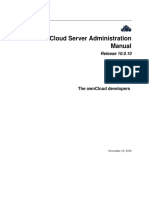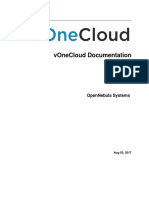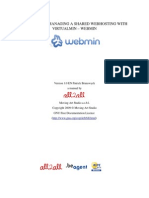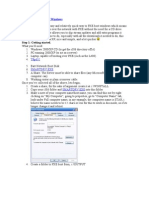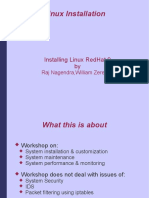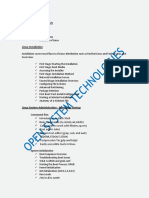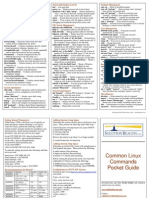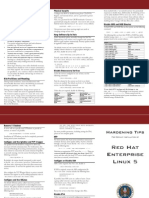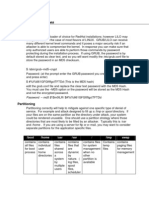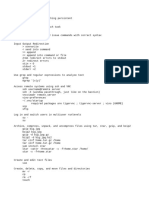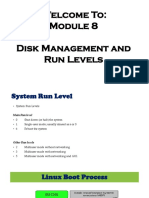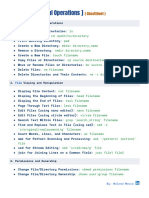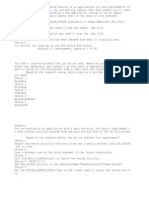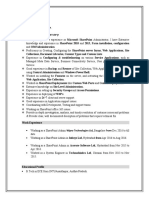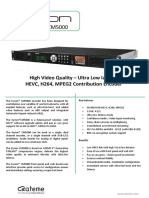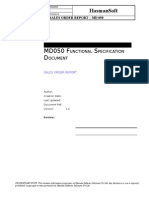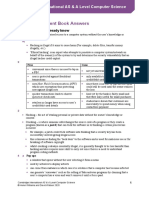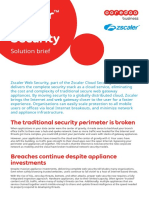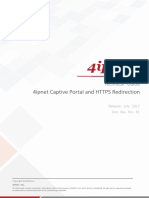Linux Installation
What this is about
Workshop on:
System installation & customization
System maintenance
System performance & monitoring
Workshop does not deal with issues of:
System Security
IDS
Packet filtering using iptables
�Overview
The object of this seminar is to provide
comprehensive check list of the more important
steps to be taken to install a linux system.
cont...
�Overview continued
Although the labs can be done without a lot of
background in UNIX systems programming, it is
advisable to have some basic concepts of the
following topics:
1. Basic scripts
2. Sed and awk expressions
3. Regular expressions
4. Setting up UDP and TCP sockets
�Overview cont.
5. Setting up DNS servers
6. Setting up a web server
Enjoy the seminar
Raj Nagendra
William Zereneh
�Introduction
1. System Installation and Customization
2. System Maintenance
3. System Performance and Monitoring
�1. Installation and Customization
Hardware compatibility
Disk space
Installation method
Installation class
Personal Desktop Installation
Workstation Installation
Server Installation
Custom Installation
Upgrade
�1. Installation and Customization
Hardware Information
Where to get information about hardware
Record your system's hardware
�1. Installation and Customization
The Graphical Installation Program
The Text Mode Installation Program
Keyboard Navigation
Displaying Online Help
Starting the Installation Program
Virtual Consoles
Booting the Installation Program
Selecting an Installation Method
Installing from CD-ROM
Problems detecting the CD-ROM
�1. Installation and Customization
Installing from a Hard Drive
Preparing for a Network Installation
Server setup
Installing via NFS
Installing via FTP
Installing via HTTP
Welcome to RedHat Linux
Language Configuration
Keyboard Configuration
Mouse Configuration
�1. Installation and Customization
Choosing to Upgrade or Install
Installation Type
Disk Partitioning Setup
Automatic Partitioning
Partitioning Your System
Graphical Display of Hard Drive(s)
Disk Druid's Buttons
Partition Fields
Recommended Partition Scheme
Adding/Editing/Deleting Partitions
�1. Installation and Customization
Boot Loader Configuration
Advanced Boot Loader Configuration
Rescue Mode
Alternative Boot Loaders
SMP Motherboards, GRUP, and LILO
Network Configuration
Firewall Configuration
Language Support Selection
Time Zone Configuration
Set Root Password
�1. Installation and Customization
Authentication Configuration
Package Group Selection
Selecting Individual Packages
Unresolved Dependencies
Preparing to Install
Installing Packages
Boot Diskette Creation
Video Card Configuration
X Configuration Monitor and
Customization
Installation Complete
�1. Installation and Customization
Configuring a Dual-Boot System
Allocating Disk Space for Linux
Installing Red Hat Linux in a Dual-Boot
Environment
Add a New Hard Drive
Use an Existing Hard Drive or Partition
Create a New Partition
Disk Partitioning
Configuring the Boot Loader
Post-Installation
Partitioning with parted
Partitioning a Windows System
�1. Kerberos
Kerberos is a network authentication protocol created
by MIT which uses symmetric key cryptography.
Design goal is to eliminate the need to send
passwords over the network
Advantages
Conventional networks require password-based
authentication schemes
Such schemes requires username and password
Transmission of authentication information for many services
is unencrypted
KERBEROS NEVER SENDS PASSWORDS ACROSS THE
NETWORK
�1. Kerberos Cont.
Disadvantages
Implementation is difficult
Account information migration from UNIX password database
to a Kerberos password can be tedious
Partial compatibility with Pluggable Authentication Modules
PAM
Applications need to be modified to utilize Kerberos
Assumes a trusted user using an untrusted host on an
untrusted network, but if Key Distribution Center (KDC) is
compromised, then the entire Kerberos authentication system
will be at risk.
All or nothing solution. must use PAM or kerberized versions
of all clients/server applications
�1. Kerberos Cont.
How does it work?
Three-way authentication, client/server and KDC
User authenticate to a service by sending a request to KDC
KDC sends a Ticket Granting Ticket (TGT) encrypted with
user's key back to user
Services (kinit,klogin,..) on the client machine then decrypts
the TGT using the user's key (which is derived from the user's
password). User's key is used only on the client machine,
never sent on the network.
If client provides correct password, then TGT will be
decrypted and therefore used for subsequent request,
otherwise authentication fails.
The TGT is set to expire after a certain period of time defined
by Network Administrator
�2. System Maintenance
Update Packages - up2date
Install/Remove Packages - RPM
Resize Existing Partition resize2fs
NOTE: boot into rescue mode
Create New Partition - fdisk
Mount File System
Create Swap File/Partition
dd if=/dev/zero of=/swapfile bs=1M count=512
mkswap /swapfile
swapon /swapfile
Make it Permanent: edit /etc/fstab and add:
/swapfile
none swapdefaults
00
�2. System Maintenance
Run levels
/etc/inittab
Change run level for system maintenance
Halt System: /sbin/init 0
Single User: /sbin/init 1
Multiuser: /sbin/init 2
Full Multiuser: /sbin/init 3
Graphical: /sbin/init 5
Reboot System: /sbin/init 6
�2. System Maintenance
Booting Into Rescue Mode
Why? Forgotten root password
Why? New updated kernel is not booting
Boot from CD-ROM, at the prompt type
linux rescue
mount root filesystem, if not already mounted
chroot /mountpoint
passwd
Boot from CD-ROM, at the prompt type
linux rescue
mount boot filesystem, if not already mounted
edit /boot/grub/grub.conf
change option to boot old kernel
Emergency boot option
linux -b
�2. System Maintenance
File system maintenance
Documentation
Rotate /var/log files
Remove stale files from /tmp
Policies
Procedures
Changes
Network maintenance
Keep Firewall up-to-date
Keep services up-to-date
�2. System Maintenance
Planning for Disaster
Types of Disasters
Disaster: Unplanned event that disrupts the
normal operation of the organization
Hardware failures
Software failures
Environmental failures
Human errors
Backups
To restore individual file
To restore entire file system
�2. System Maintenance
Type of Backups
Full backup
Incremental backup
Only modified files are written to backup media
Differential backup - Cumulative
Every single file is written to backup media
Modified files will continue to be included in all
subsequent differential backups
Backup Media
Tape
Disk
Network
�2. System Maintenance
Backup Technologies
tar
tar vcf /mnt/backup/home.backup.tar /home/
tar vzcf /mnt/backup/home.backup.tar /home/
cpio
find /home/ | cpio -o > /mnt/backup/home.backup.cpio
find /home/ -atime +365 | cpio -o >
/mnt/backup/home.backup.cpio
AMANDA Advanced Maryland Automatic Disk
Archiver
A client/server based backup application
Single backup server; multiple clients
�3. System Performance and
Monitoring
Tuning IDE Hard Disk Performance
Put swap partition near the beginning of hard
drive
Hard disk read timing
/sbin/hdparm -t /dev/hdaX
Enable 32-bit Transferes
/sbin/hdparm -c1 /dev/hdX
Enable DMA using_dma flag
/sbin/hdparm -d1 /dev/hdX
Show information
/sbin/hdparm -i /dev/hdX
�3. System Performance and
Monitoring
Network
Change the following TCP/IP values
edit /etc/sysctl.conf
change/add
# Decrease the time default value for tcp_fin_timeout connection
net.ipv4.tcp_fin_timeout = 30
# Decrease the time default value for tcp_keepalive_time connection
net.ipv4.tcp_keepalive_time = 1800
# Turn off the tcp_window_scaling
net.ipv4.tcp_window_scaling = 0
# Turn off the tcp_sack
net.ipv4.tcp_sack = 0
# Turn off the tcp_timestamps
net.ipv4.tcp_timestamps = 0
Restart network - /etc/init.d/network restart
�3. System Performance and
Monitoring
File System
ext3 over ext2
/bin/umount /dev/hdaX
/sbin/tune2fs -j /dev/hdaX
edit /etc/fstab change ext2 to ext3 for /dev/hdaX
/bin/mount /dev/hdaX
Maximum number of file handles allocated
by the kernel - file-max parameter
Aprox: 256 file for every 4M
Edit /etc/sysctl.conf add/change
# Improve the number of open files
fs.file-max = 8192 # for a 128M machine
�3. System Performance and
Monitoring
Access Time
Linux records information about when files were
created, last modified and last accessed
Highly accessed files should have atime
attribute removed
/usr/bin/chattr -R +A /var/spool/
noatime mount parameter
edit /etc/fstab and add noatime option
/dev/hdaX
/chroot
ext3
defaults,noatime
1 2
�3. System Performance and
Monitoring
Resource Monitoring
What to Monitor? Resources
CPU Power
Bandwidth
Memory
Storage
Utilities to use for CPU, Bandwidth and Memory
free
top
vmstat
�3. System Performance and
Monitoring
free The free command displays system
memory utilization
Example:
total
used
free shared
Mem:
255508 240268
15240
86188
-/+ buffers/cache: 146488 109020
Swap:
530136
26268 503868
Automate free
/usr/bin/watch -n 1 -d free
buffers cached
0
7592
�3. System Performance and
Monitoring
top Displays CPU utilization, process
statistics, memory utilization
example
14:18:52 up 16 days, 21:37, 1 user, load average: 0.07, 0.02, 0.00
71 processes: 70 sleeping, 1 running, 0 zombie, 0 stopped
CPU0 states: 0.0% user 0.0% system 0.0% nice 0.0% iowait 100.0% idle
CPU1 states: 2.0% user 6.0% system 0.0% nice 0.0% iowait 90.0% idle
Mem: 513232k av, 505424k used, 7808k free,
0k shrd, 66464k buff
379364k actv,
0k in_d, 12044k in_c
Swap: 417648k av, 108724k used, 308924k free
325384k cached
PID USER
18866 root
PRI NI SIZE RSS SHARE STAT %CPU %MEM TIME CPU COMMAND
20 0 984 984 788 R 6.5 0.1 0:00 1 top
�3. System Performance and
Monitoring
vmstat Display process, memory, swap,
I/O, system and CPU activity
example:
procs
memory
swap
io system
cpu
r b w swpd free buff cache si so bi bo in cs us sy id
0 0 0 108724 6400 66452 325664 0 0 5 6 10 10 2 1 8
r Runnable processes state
b Uninterruptible sleep state
w Swaped out, but runnable
si swaped in
so swaped out
�3. System Performance and
Monitoring
Other monitoring tools
The Sysstat suite
/usr/bin/iostat
/usr/bin/mpstat
/usr/bin/sar
�3. System Performance and
Monitoring
Storage
Utilities to use for Storage
smartd/smartctl
df
du
badblocks
smartd is a daemon that monitors the SelfMonitoring, Analysis and Reporting Technology
System (S.M.A.R.T.) built into ATA-3 and later
IDE and SCSI-3 hard drive.
/usr/sbin/smartctl -i /dev/hda
Device: Maxtor 90650U2 Supports ATA Version 5
Drive supports S.M.A.R.T. and is enabled
�3. System Performance and
Monitoring
df Disk free
/bin/df
Filesystem
/dev/hda5
/dev/hda1
none
1K-blocks
Used Available Use% Mounted on
5578804 4279424 1298180 77% /
108868
9899 93348 10% /boot
256616
0 256616 0% /dev/shm
du Disk usage
/usr/bin/du /tmp
du /tmp/
4
/tmp/screens/S-root
8
/tmp/screens
.....
4
/tmp/ssh-XXa4kqTn
4
/tmp/uscreens/S-donkey
8
/tmp/uscreens
88
/tmp
�3. System Performance and
Monitoring
Other monitoring tools
smartd
Big Brother - bb
Multi Router Traffic Grapher - mrtg
logwatch
.....
�References
www.redhat.com
www.disasterplan.com
www.amanda.org
www.linux-backup.net
http://web.mit.edu/kerberos/








